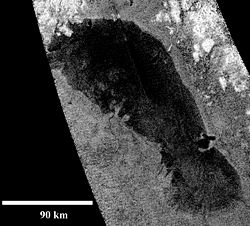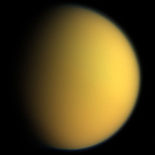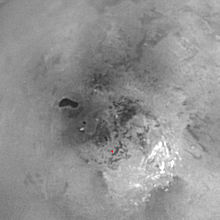- Ontario Lacus
-
Ontario Lacūs 
RADAR-image of Ontario Lacūs taken by Cassini on January 12, 2010.Feature type Lacūs Coordinates 72°S 183°W / 72°S 183°WCoordinates: 72°S 183°W / 72°S 183°W Diameter 235 km Eponym Lake Ontario Ontario Lacūs is a lake composed of methane, ethane and propane near the south pole of Saturn's moon Titan. Its character as a hydrocarbon lake was confirmed[1] by observations from the Cassini spacecraft, published in the 31 July 2008 edition of Nature. Ontario Lacūs has a surface area of about 15,000 square kilometers (5,800 sq mi), slightly smaller than its terrestrial namesake, Lake Ontario in North America.
On January 12, 2010, Cassini took a more detailed radar-image of Ontario Lacūs showing numerous remarkable features. The northern shoreline features low hills, probably about 1 kilometer (3,000 feet) in altitude, and flooded river valleys. A smooth, wave-sculpted shoreline, like that seen on the southeastern side of Lake Michigan, can be seen at the northeastern part of the lake. Smooth lines parallel to the current shoreline could be formed by low waves over time, which were likely driven by winds sweeping in from the west or southwest. The southeast shore features a round-headed bay intruding into the shore.
The middle part of the western shoreline shows the first well-developed river delta observed on Titan, showing that liquid hydrocarbons flowing down from a higher plain have switched channels on their way into the lake, forming at least two lobes. Examples of this kind of channel switching and wave-modified deltas can be found on Earth at the southern end of Lake Albert between Uganda and the Democratic Republic of Congo in Africa and the remains of an ancient lake known as Megachad in the African country Chad.[2]
By terrestrial standards, the lake appears to be extremely shallow. Radar measurements made in July 2009 and January 2010 indicate an average depth of 0.4 – 3.2 m, and a maximum depth of 2.9 – 7.4 m.[3] This gives the lake an estimated volume of 7 to 50 km3, less than one thirtieth the volume of Earth's Lake Ontario. Any waves present on the lake are also far smaller than those that would be present on a sizable body of liquid water on Earth; their estimated maximum height is less than 1 mm. This could either indicate a complete lack of wind, or a viscous composition of the hydrocarbon fluid.[3]
References
- ^ "NASA Confirms Liquid Lake On Saturn Moon". NASA. 2007-07-30. http://www.nasa.gov/mission_pages/cassini/media/cassini-20080730.html. Retrieved 2007-07-30.
- ^ http://photojournal.jpl.nasa.gov/catalog/PIA13172
- ^ a b Wall, Mike (2010-12-17). "Saturn Moon's 'Lake Ontario': Shallow and Virtually Wave-free". Space.Com web site. http://www.space.com/scienceastronomy/saturn-titan-lake-ontario-depth-flat-101217.html. Retrieved 2010-12-19.
External links
- NASA/JPL videos describing recent discoveries about Ontario Lacus
- Staff (2008-08-03). "Titan's Ethane Lake". Astrobiology Magazine. http://www.astrobio.net/news/modules.php?op=modload&name=News&file=article&sid=2829&mode=thread&order=0&thold=0. Retrieved 2008-08-05.
- Wye, Lauren; Zebker, Howard (2009-12-02). "Titan's Ontario Lacus: Smoothness Constraints from Cassini RADAR". SETI Institute Colloquium Series. Cosmo Learning. http://www.cosmolearning.com/video-lectures/lauren-wye-titans-ontario-lacus-7514/. Retrieved 2010-12-21.
General - Titan
- Lakes of Titan
- Atmosphere of Titan
- Life on Titan

Lists Lakes - Kraken Mare
- Ligeia Mare
- Ontario Lacus
Features - Adiri
- Ganesa Macula
- Guabonito (crater)
- Shangri-la
- Shikoku Facula
- Sotra Facula
- Tui Regio
- Xanadu
Exploration - Cassini–Huygens
- Huygens (spacecraft)
- Titan Saturn System Mission
- Titan Mare Explorer
- Colonization of Titan
Other topics Categories:- Surface features of Titan
Wikimedia Foundation. 2010.

